Effect of Arc Length on Oxygen Content and Mechanical Properties of Weld Metal during Pulsed GMAW
Abstract
:1. Introduction
2. Experimental Method
3. Results and Discussion
3.1. Effect of Arc Length on Oxygen Content of Weld Metal
3.2. Effect of Arc Length on Mechanical Properties of Weld Metal
4. Conclusions
- (1)
- As the arc length raised from 2.9 mm to 9.2 mm, the transfer time increased but the droplet size diminished. Meanwhile, the oxidation reacted more completely in the droplet transfer zone, and the oxygen content of the weld metal increased significantly from 217 ppm to 372 ppm.
- (2)
- When the arc length increased from 2.9 mm to 9.2 mm, the tensile strength of the weld metal reduced from 781 MPa to 729 MPa but the −40 °C impact energy heightened from 79 J to 116 J.
- (3)
- Due to the longer arc, the proportion of AF in the microstructure decreased, but the proportion of LB and GB decreased. With the rise of arc length, the cleavage step morphology decreased in the impact fracture however, the dimples increased.
- (4)
- The more oxygen content of weld metal was useful for the formation of inclusions in impact fracture. Inclusions promoted the nucleation of acicular ferrite and dimples, contributing to the growth of plasticity and toughness of weld metal.
Author Contributions
Funding
Institutional Review Board Statement
Informed Consent Statement
Data Availability Statement
Acknowledgments
Conflicts of Interest
References
- Xu, Y.; Fang, G.; Lv, N.; Chen, S.; Zou, J.J. Computer Vision Technology for Seam Tracking in Robotic GTAW and GMAW. Robot. Comput.-Integr. Manuf. 2015, 32, 25–36. [Google Scholar] [CrossRef]
- Xu, Y.; Lv, N.; Fang, G.; Du, S.; Zhao, W.; Ye, Z.; Chen, S. Welding Seam Tracking in Robotic Gas Metal Arc Welding. J. Mater. Process. Technol. 2017, 248, 18–30. [Google Scholar] [CrossRef]
- Kozakov, R.; Gött, G.; Schöpp, H.; Uhrlandt, D.; Schnick, M.; Häßler, M.; Füssel, U.; Rose, S. Spatial Structure of the Arc in a Pulsed GMAW Process. J. Phys. D Appl. Phys. 2013, 46, 224001. [Google Scholar] [CrossRef]
- Pal, K.; Pal, S.K. Effect of Pulse Parameters on Weld Quality in Pulsed Gas Metal Arc Welding: A Review. J. Mater. Eng. Perform. 2011, 20, 918–931. [Google Scholar] [CrossRef]
- Ghosh, P.K.; Goyal, V.K.; Dhiman, H.K.; Kumar, M. Thermal and Metal Transfer Behaviours in Pulsed Current Gas Metal Arc Weld Deposition of Al–Mg Alloy. Sci. Technol. Weld. Join. 2006, 11, 232–242. [Google Scholar] [CrossRef]
- Wu, C.S.; Chen, M.A.; Lu, Y.F. Effect of Current Waveforms on Metal Transfer in Pulsed Gas Metal Arc Welding. Meas. Sci. Technol. 2005, 16, 2459–2465. [Google Scholar] [CrossRef]
- Amin, M. Pulse Current Parameters for Arc Stability and Controlled Metal Transfer in Arc Welding. Met. Constr. 1983, 15, 272–278. [Google Scholar]
- Rajasekaran, S. Weld Bead Characteristics in Pulsed GMA Welding of Al-Mg Alloys. Weld. J. 1999, 78, 397s–407s. [Google Scholar]
- Rajasekaran, S.; Kulkarni, S.D.; Mallya, U.D.; Chaturvedi, R.C. Droplet Detachment and Plate Fusion Characteristics in Pulsed Current Gas Metal Arc Welding. Weld. J. 1998, 77, 254s–269s. [Google Scholar]
- Harwig, D.D.; Dierksheide, J.E.; Yapp, D.; Blackman, S. Arc Behavior and Melting Rate in the VP-GMAW Process. Weld. J. 2006, 85, 52s–62s. [Google Scholar]
- Chen, C.; Fan, C.; Cai, X.; Lin, S.; Yang, C. Analysis of Droplet Transfer, Weld Formation and Microstructure in Al-Cu Alloy Bead Welding Joint with Pulsed Ultrasonic-GMAW Method. J. Mater. Process. Technol. 2019, 271, 144–151. [Google Scholar] [CrossRef]
- Tong, H.; Ueyama, T.; Tanaka, M.; Ushio, M. Observations of the Phenomenon of Abnormal Arc Voltage Occurring in Pulsed Metal Inert Gas Welding of Aluminum Alloy. Sci. Technol. Weld. Join. 2005, 10, 695–700. [Google Scholar] [CrossRef]
- Wang, Q.; Qi, B.; Cong, B.; Yang, M. Output Characteristic and Arc Length Control of Pulsed Gas Metal Arc Welding Process. J. Manuf. Process. 2017, 29, 427–437. [Google Scholar] [CrossRef]
- Zhu, Z.; Wu, W.; Chen, Q. Random Nature of Droplet Size and Its Origins in Short Circuit CO2 Arc Welding. Sci. Technol. Weld. Join. 2013, 10, 636–642. [Google Scholar] [CrossRef]
- American Welding Society. AWS B4.0-2016, Standard Methods for Mechanical Testing of Welds; American National Standards Institute: Orlando, FL, USA, 2016. [Google Scholar]
- Zhang, T.; Li, Z.; Kou, S.; Jing, H.; Li, G.; Li, H.; Kim, H.J. Effect of inclusions on microstructure and toughness of deposited metals of self-shielded flux cored wires. Mater. Sci. Eng. A 2015, 628, 332–339. [Google Scholar] [CrossRef]
- Zhang, T.; Li, Z.; Ma, S.; Kou, S.; Jing, H. High strength steel (600–900 MPa) deposited metals: Microstructure and mechanical properties. Sci. Technol. Weld. Join. 2016, 21, 186–193. [Google Scholar] [CrossRef]

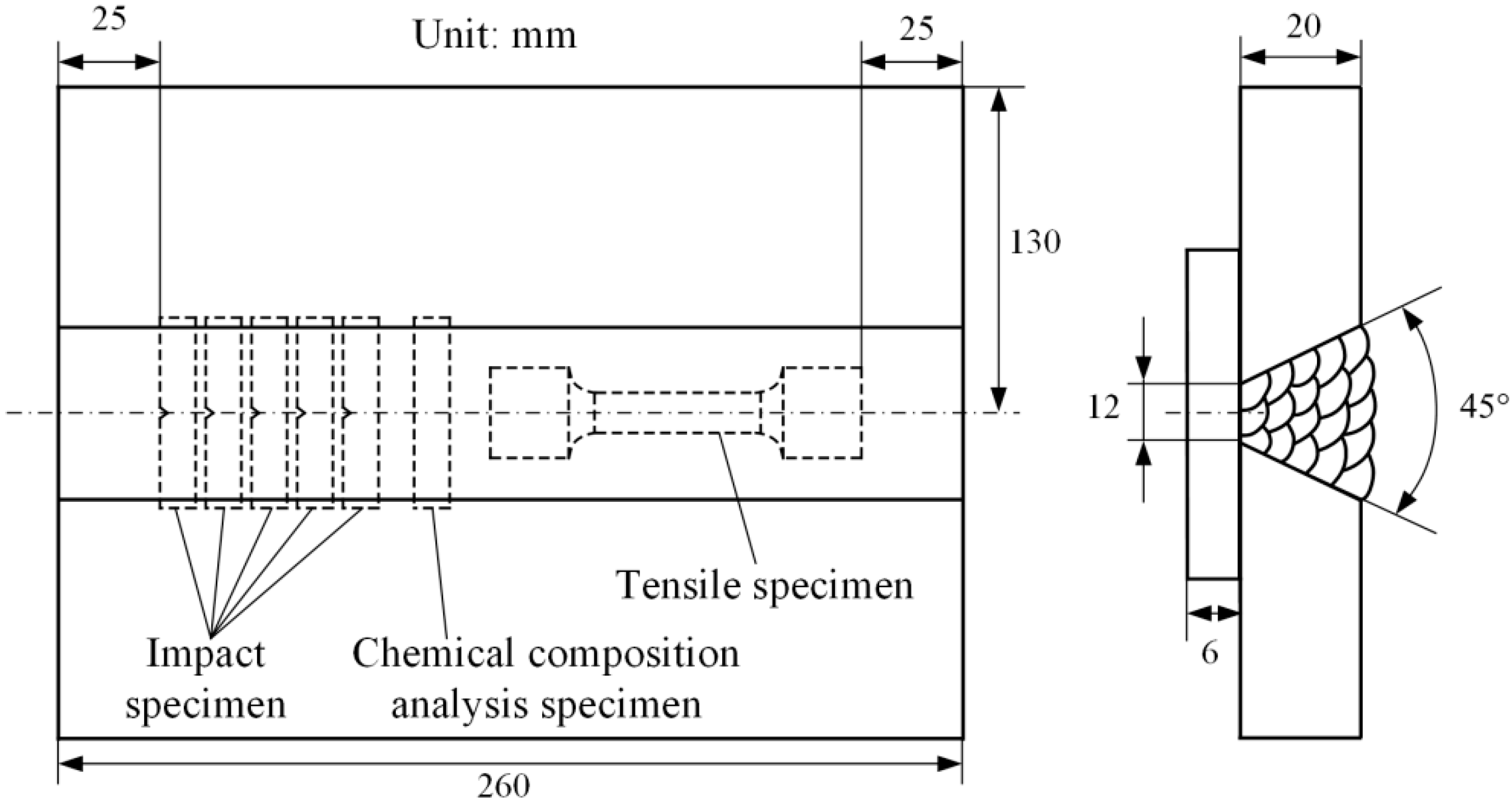

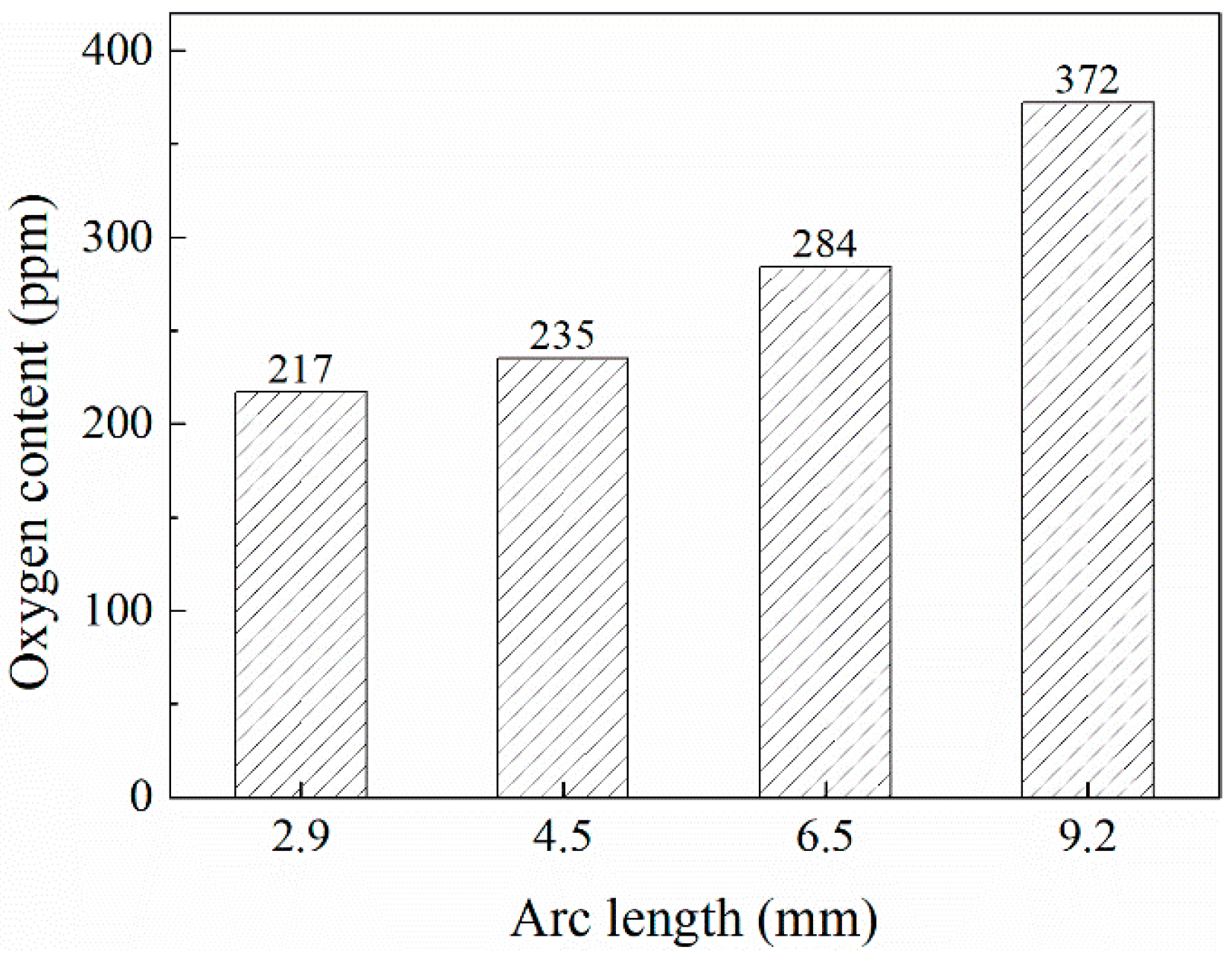
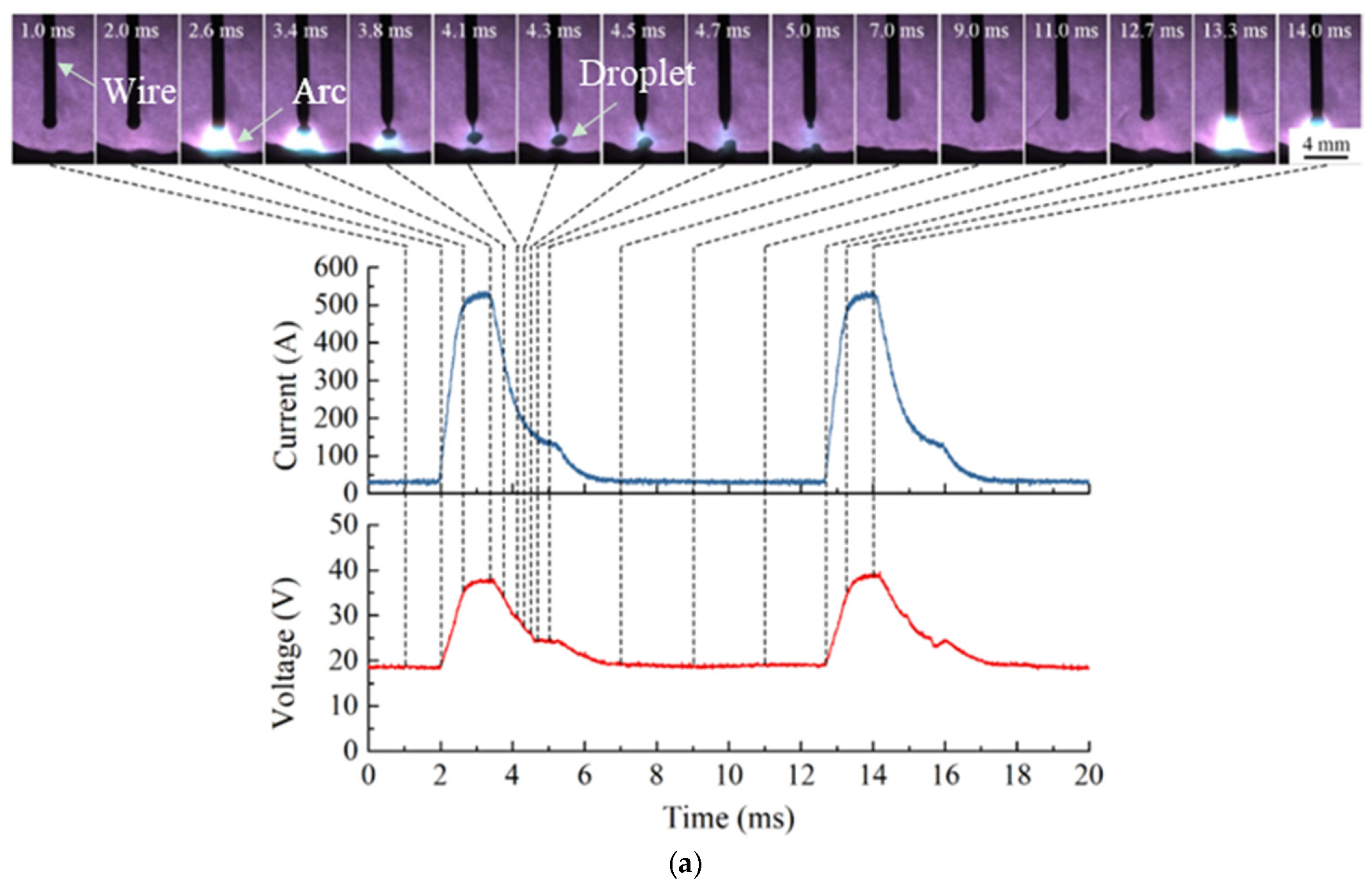
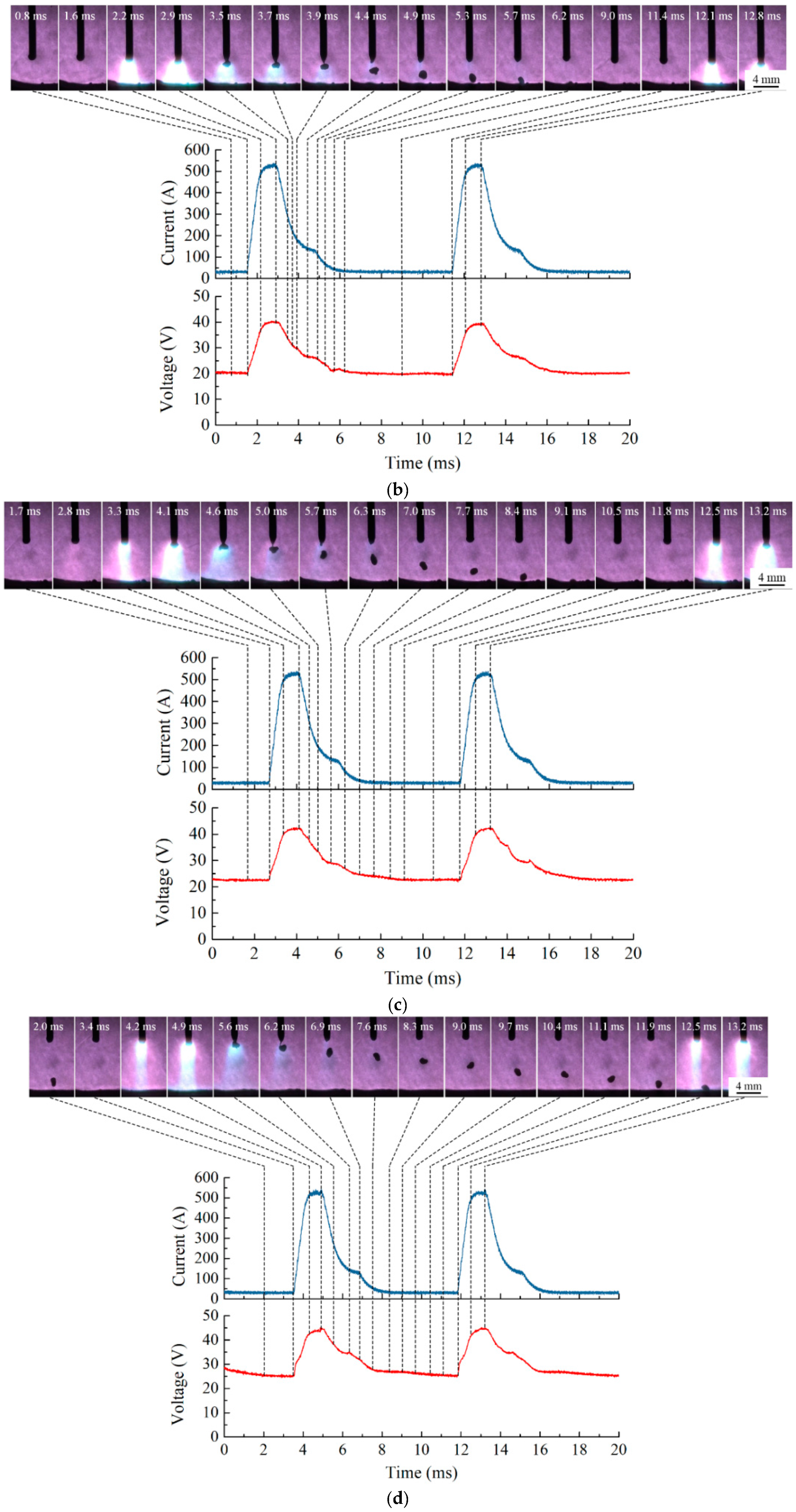
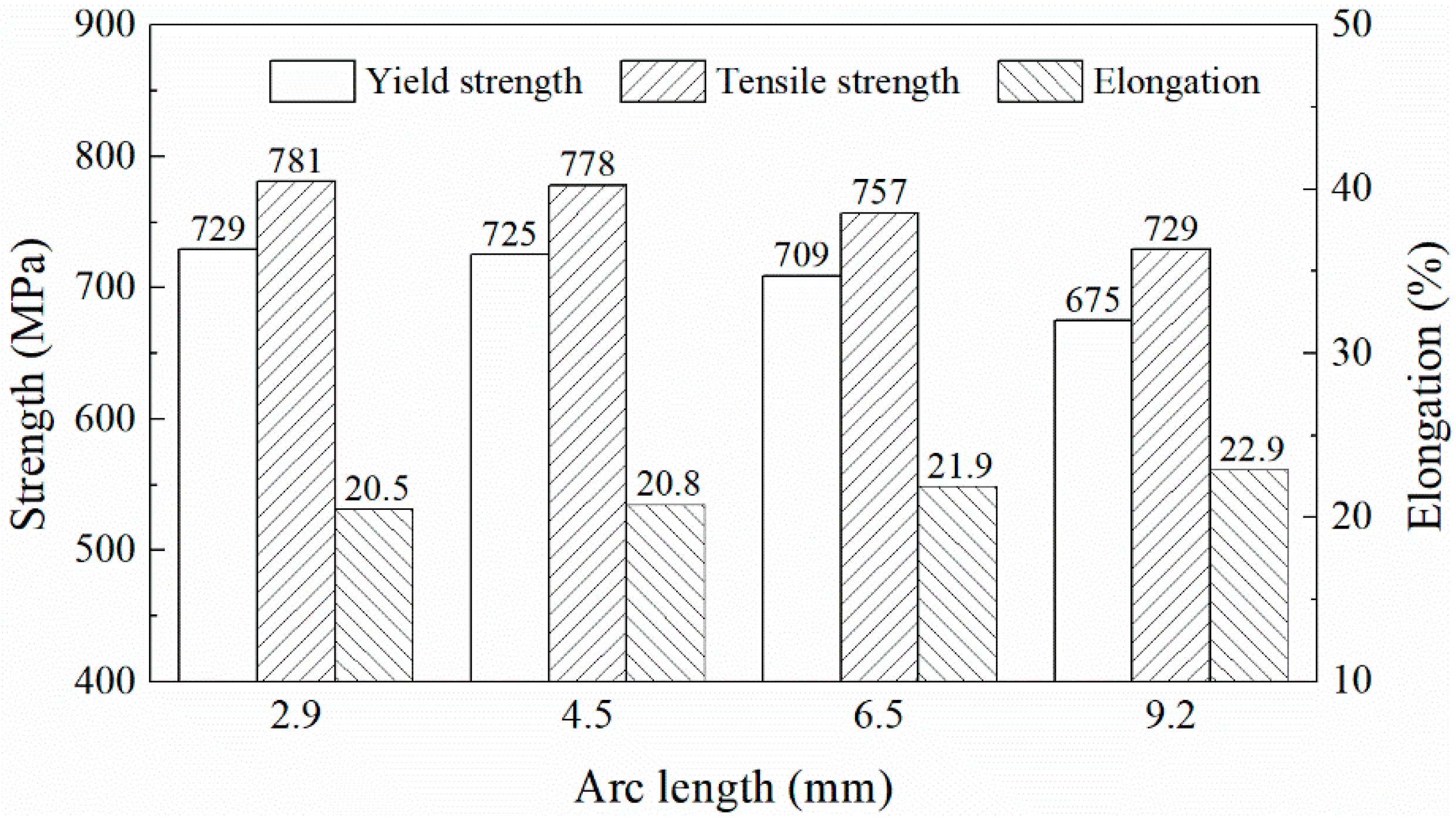
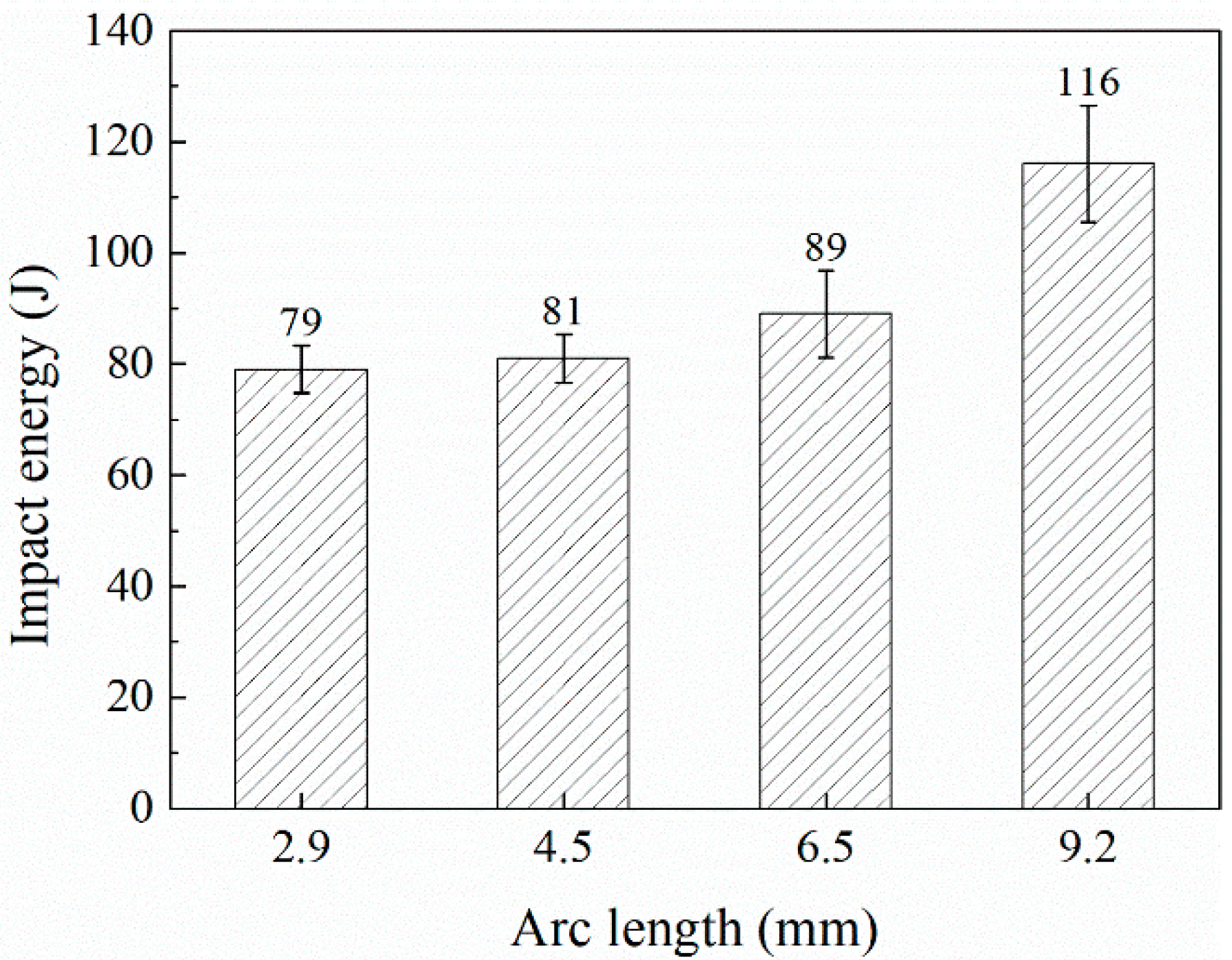
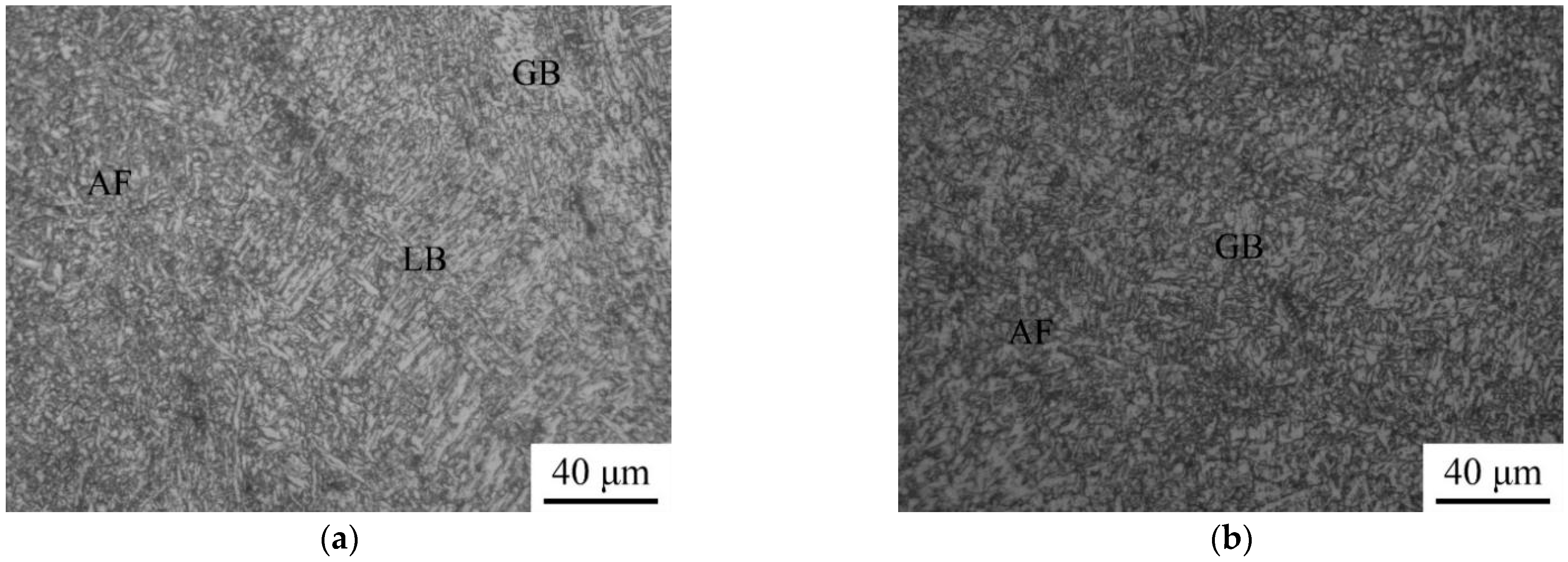


| Welding Parameters | Test 1 | Test 2 | Test 3 | Test 4 |
|---|---|---|---|---|
| Contact tube-to-work distance, mm | 20 | |||
| Pulse peak current, A | 525 | |||
| Pulse peak current time, ms | 1.6 | |||
| Pulse base current, A | 28 | |||
| Pulse base current time, ms | 9 | 8.2 | 7.4 | 6.6 |
| Arc shielding gas | 82% Ar + 18% CO2 | |||
| Flow rate of arc shielding gas, L·min−1 | 18 | |||
| Speed of wire feed, m·min−1 | 4 | |||
| Welding speed, mm·s−1 | 4 | |||
| Arc length, mm | 2.9 | 4.5 | 6.5 | 9.2 |
| Average current, A | 122 | 130 | 139 | 149 |
| Average voltage, V | 22.4 | 25.9 | 28.1 | 31.3 |
| C | Si | Mn | Cu | Cr | Ni | Mo | Al | Ti |
|---|---|---|---|---|---|---|---|---|
| 0.073 | 0.59 | 1.62 | 0.25 | 0.09 | 1.78 | 0.033 | 0.028 | 0.023 |
| Arc Length La/mm | C | Si | Mn | Cu | Cr | Ni | Mo | Al | Ti |
|---|---|---|---|---|---|---|---|---|---|
| 2.9 | 0.063 | 0.47 | 1.51 | 0.19 | 0.07 | 1.71 | 0.029 | 0.017 | 0.017 |
| 4.5 | 0.062 | 0.46 | 1.49 | 0.18 | 0.06 | 1.71 | 0.029 | 0.016 | 0.016 |
| 6.5 | 0.053 | 0.41 | 1.42 | 0.16 | 0.04 | 1.66 | 0.026 | 0.009 | 0.009 |
| 9.2 | 0.047 | 0.38 | 1.37 | 0.13 | 0.02 | 1.61 | 0.022 | 0.006 | 0.007 |
Publisher’s Note: MDPI stays neutral with regard to jurisdictional claims in published maps and institutional affiliations. |
© 2022 by the authors. Licensee MDPI, Basel, Switzerland. This article is an open access article distributed under the terms and conditions of the Creative Commons Attribution (CC BY) license (https://creativecommons.org/licenses/by/4.0/).
Share and Cite
Xu, J.; Zhou, X.; Zhu, D. Effect of Arc Length on Oxygen Content and Mechanical Properties of Weld Metal during Pulsed GMAW. Crystals 2022, 12, 176. https://doi.org/10.3390/cryst12020176
Xu J, Zhou X, Zhu D. Effect of Arc Length on Oxygen Content and Mechanical Properties of Weld Metal during Pulsed GMAW. Crystals. 2022; 12(2):176. https://doi.org/10.3390/cryst12020176
Chicago/Turabian StyleXu, Jiachen, Xiaoxiao Zhou, and Dawei Zhu. 2022. "Effect of Arc Length on Oxygen Content and Mechanical Properties of Weld Metal during Pulsed GMAW" Crystals 12, no. 2: 176. https://doi.org/10.3390/cryst12020176





